

Full-day country walks in
SE England and beyond
Coulsdon circular
Click on the image below to access
the full map on plotaroute
Distance: 6.7 miles.
Time without long breaks: 4 hrs.
Terrain: Easy but a few very moderate hills.
How to get there and back: Catch a train to Coulsdon South and back. Trains run from Victoria (journey time apx 30 minutes) and also from London Thameslink stations. All trains go via East Croydon.
Pubs: There is one pub on this route, The Fox on Coulsdon Common.
More information: This is a brilliant walk for dog walkers who want to escape the city. The Fox, a suburban country inn, is a dog-friendly pub.

This comfortable trek is the closest on this site to central London and is within the M25, but it still has the feel of a proper country walk. Its easy accessibility makes it ideal for a weekend afternoon stroll, particularly as it is one of the shorter routes on here. It takes in the protected areas of Farthing Downs and Happy Valley, as well as part of Coulsdon Common, following sections of the Downlands Circular Walk and the London Loop. The route also includes beautiful Chaldon Church, which has a remarkable medieval 'doom' painting (see panel). The Fox pub is conveniently located for a mid-walk break.
Take the platform two exit from the station and follow the passage that emerges via steps at Reddown Road. Turn left and walk down to the junction. Turn right along the main road, then right again into Downs Road. Take the lower road ahead of you on the left. Soon you will come to some gates and a cattle grid which lead to open common land. Take the small gate on the left and follow the path, parallel to the line of trees. This is Farthing Downs, once home to Stone Age hunters and Iron Age farmers. It is now mostly used by dog walkers and joggers, although cattle are still grazed here.

Just after you pass a farm gate on the left, the track forks. Take the track on the right. Where the trees end shortly after this, there is another fork. This time, take the path on the left This is Happy Valley, a designated Site of Special Scientific Interest, and home to dormice, rare species of butterfly, the greater yellow rattle and the bee orchid. Carry on along the path until you reach a junction of tracks, where the path starts to go uphill. You will see a bench and wooden signpost ahead, just before the trees. This is a perfect spot to stop for a rest and admire the views below.

Go through the gate and carry on in the same direction down the lane opposite which runs between houses. This soon becomes a track, bordered by modern houses on the left-hand side. This residential development has been built on the site of the old Caterham army barracks (given away by some of the street names). After about 350m down the lane, turn right down a wooded track. In about half a mile you come to a junction of tracks and a signpost on the edge of a field. Rather than go into the field, walk round to the left and take the path into the wood, heading uphill. The track runs alongside a wooden fence on your left until it emerges at the bottom of a lane near the driveway to a house.

After a short distance, turn right following the wooden sign. This takes you back into the field you were before. This time, head diagonally across, heading slightly uphill, following the well-defined path. Keep going through the next field, heading towards some trees. You come out by a signpost back at the top of Happy Valley. Turn left and head diagonally across the field towards the valley bottom, aiming for a gap in the trees. Go between the trees and then in a short distance, at a crossroads of paths, take the one that branches off on your left, heading uphill towards Devil's Den woods. Follow the track through the woods, ignoring any turnings. Turn left when you emerge from the trees to walk up past houses to some public toilets and a car park.


Keep to the path, in line with the trees and passing some telegraph poles. After nearly a mile, you will see a wooden fence and some buildings up on the hill ahead. Go through the small wooden gate at the bottom of the fence. A very short distance further on, you will spot a post next to a broad chalky track that crosses your path. Turn left here into the wood. Ignore the path that comes off immediately to your right, but take the next one on the right, going past a small bench. This path winds down to meet a wide grassy thoroughfare between trees. Turn right, and walk down the track, passing a memorial bench on your right.

Carry on in the same direction through the trees and across a field, which slopes down to your right. This section is part of the London Loop. At the end of the field, ignore the path that comes off to the right, but follow the track as it bears to the left into the trees. This becomes a small lane, with a large open field to your right. Passing a car park on the right, follow the road until you reach The Fox Inn. On leaving the pub, go straight ahead and turn right to cross the green, aiming for a small wooden gate in the fence. Carry on along the path straight ahead, bearing slightly right between two trees to reach a wooden gate with a farm gate alongside it.

Carry on down the lane, past some more houses. After about 250m, when you reach a wooden signpost, turn right down a path with paving stones. With trees on your right and then open fields, after 400m you come to a lane. Turn right and then left to reach Chaldon Church. The village of 'Chalvedune' appears in the Doomsday Book and the present building dates from around the same time, although there was a church here as early as 727. The church's most striking feature is its 'doom' mural (see below), which has been described as one of the most important medieval wall paintings in England. On leaving the church, turn left and walk down to the road, past the village sign and a signpost.

You are back on Farthing Downs. Head straight ahead along the left side of the car park and you will come to some unusual circular wooden seating with a collection of various information boards. Proceed ahead through a gate following the path along the ridge as it runs parallel to the road. A little further on, to your right, you will see a cairn and topograph displaying features on the horizon, including the London skyline which you can now see ahead of you. Just beyond this you will pass a clump of trees known as The Folly and a wooden signpost. Keep going straight ahead. The path goes gradually downhill until you reach the gates you were at a few hours ago. Retrace your steps to the station.
The approach to St Peter and St Paul Church in Chaldon is picturesque and its churchyard has a tranquil vibe. When A Trip Out visited there were ribbons blowing in the trees and flowers blooming among the gravestones. But this gentle appearance does not prepare you for the horrors that lie within. On the west wall is a huge 'doom' mural depicting the last judgement, with tortured souls enduring unspeakable acts of violence from monstrous giant demons. Other examples we have encountered (such as the one at Lower Oddington – see walk 39) have been a bit more bawdy – almost making hell look like the preferable option to heaven's piety. But there is nothing here that suggests there will be Dionysian fun down in hell. The seven deadly sins appear to be represented with bespoke punishments for each. People are boiled in a pot, some poor soul has his genitals roasted over a flame, hapless workmen must make their way over a spiky bridge.


But all is not without hope. If folk can make their way on to the purgatorial ladder they can climb to heaven, where the angels are – although they will still face one more hurdle, the reckoning of the weighing scales, assessing their worldly actions. Just watch out for the Devil pushing down on the scales. He is determined to see them fail – a bit like one of the big bosses you must fight at the end of a Sonic game. It has been suggested that this doom was painted in the 12th century by a travelling monk who was familiar with Greek art. It is also thought to be one of the earliest examples of such a mural in the country. What did the churchgoers make of it? Did it succeed in making them behave during their lives, struck with fear of the afterlife? The painting was covered up for a while, which saved it from destruction in the reformation, but was discovered in 1869 during renovations. As church wall paintings go, A Trip Out prefers the calm of the Sussex downs murals in Berwick Church (see walk 24), but we’re glad these Hieronymus Bosch-like trolls are here in Chaldon. BH
Walks by County
Listed by the most traversed
county for each route
Berkshire
Buckinghamshire
Henley circular
Pr. Risborough-Wendover
Tring circular
Tring-Leighton Buzzard
Cambridgeshire
Cambridge-Trumpington
Whittlesford-Wandlebury
Derbyshire
Edale-Hope
Dorset
Corfe Castle-W. Matravers
East Sussex
Ashdown Forest
Berwick circular
Berwick-Seaford
Cuckmere Haven-E'bourne
Forest Row-Eridge
Glynde-Berwick
Glynde-Seven Sisters
Isfield-Lewes
Lewes circular 1
Lewes circular 2
Lewes-Hassocks
Lewes-Rottingdean
Plumpton-Hassocks
Rye-Three Oaks
Gloucestershire
Kingham circular
Toddington-Cleeve Hill
Hertfordshire
Codicote-St Albans
Odsey-Royston
Kent
Oxfordshire
Surrey
West Sussex
Bramber-Amberley
Steyning circular
West Yorkshire
Haworth-Hebden Bridge
Wiltshire
Avebury circular
